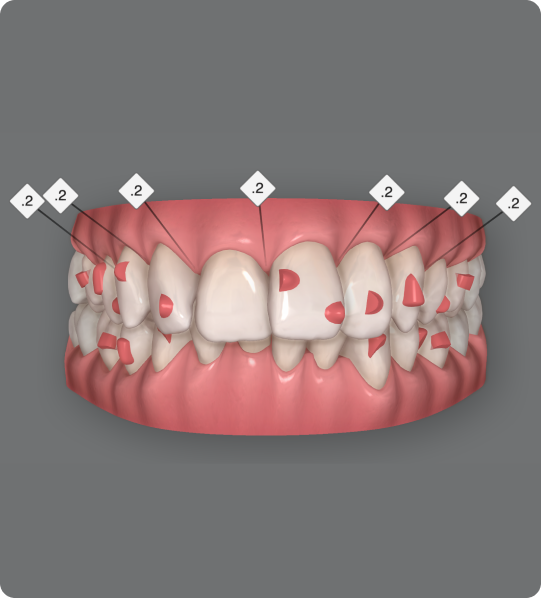Google rating score of 4.8 of 5, based on 500+ reviews
Free Invisalign Consultation
- Free no obligation Invisalign consultation
- Before and after simulation of your smile makeover
- Free Clincheck (usually £500)
What to expect during your Invisalign consultation?

Get to know you
We want to understand your concerns and get to know you, We need to understand what you would like to improve in order for us to give you the best results
Health Check
We need to ensure the teeth and gums are healthy enough to start the Invisalign process
Records
Take measurements of your bite, in addition to clinical photos and a digital scan
Digital Simulation
For you to see the change that can be achieved before you even start!
What we will discuss at your Invisalign appointment
- Visualization of results: Using a 3D scan, the dentist can show you a virtual representation of your teeth's movement during each treatment stage and the expected final result.
- Cost and financing options: A detailed breakdown of the Invisalign treatment cost, including any additional fees for appointments or adjustments, and available payment plans or financing options to make the treatment more affordable.
- Insurance coverage: Assistance in understanding your dental insurance coverage for the treatment and help with the necessary paperwork if applicable.
- Treatment timeline: An estimate of the total duration of your Invisalign treatment, including each phase's length and the frequency of appointments.
- Maintenance and care instructions: Guidance on caring for your Invisalign aligners, including hygiene practices, when to remove them, and foods or habits to avoid.
- Follow-up appointments: The importance of regular check-ups to monitor progress and make any necessary adjustments to the treatment plan.
- Potential risks and limitations: A discussion on potential risks, such as discomfort or minor side effects, and any limitations of what can be achieved with Invisalign.
- Opportunity to ask questions: A chance to ask any questions or express concerns about the treatment process to make an informed decision. instead of what is currently there under what to expect at your invisalign consultation - I have shortened the paragrpahs
Invisalign vs Fixed Braces

Next Steps - Clincheck Simulation
Clincheck simulation is the next part of the process where we take the photos, records obtained above and provide this information to Invisalign.
With our input along with the invisalign technicians, we then provide an advanced 3D simulation called a clincheck to show you the planned and predcited tooth movement before you have even started in more detail than the digital simulation.
Invisalign Consultation FAQ
What is Invisalign?
Invisalign is an orthodontic treatment that uses clear, removable aligners to gradually align teeth. The aligners are custom-made for and are virtually invisible, providing a more discreet option compared to traditional metal fixed braces.
How does Invisalign work?
Invisalign works by using a series of clear aligners that are replaced approximately every week. Each set of aligners is slightly different, gradually moving your teeth into the pre planned position. You’ll wear the aligners for 22 hours a day, only removing them to eat, drink, brush, and floss.
Who is a candidate for Invisalign?
Invisalign is suitable for most adults and teens who have mild to moderate orthodontic issues, such as crowding, spacing, and certain bite issues. With advances in the materials, it can fix problems, previously only fixable with fixed metal braces
How long does treatment take?
The duration of Invisalign treatment varies depending on the complexity of the case. On average, treatment can take anywhere from 3 to 18 months, depending on the complexity of your case.
What happens during an Invisalign consultation?
During the consultation, your orthodontist will examine your teeth, gums and discuss your treatment goals. They will take digital scans of your teeth, which are used to create a customized treatment plan. You’ll also have the opportunity to ask any questions about the process, cost, and expected results.
Are there any dietary restrictions with Invisalign?
No, because the aligners are removable. You can eat and drink whatever you like, but you must remove your aligners during meals and clean your teeth before putting the aligners back in to avoid staining and maintain oral hygiene.
How often do I need to visit the orthodontist during Invisalign treatment?
Typically, you’ll visit your orthodontist every 8-12 weeks to monitor your progress and receive the next sets of aligners. These appointments help ensure your treatment is progressing as planned.
Is Invisalign treatment painful?
You may experience some discomfort or pressure for the first few days when you start wearing a new set of aligners. This is a sign that the aligners are working to move your teeth. The discomfort is very mild and temporary.
How much does Invisalign cost?
The cost of Invisalign varies depending on the complexity of the case and the length of treatment.
Does insurance cover Invisalign?
Some dental insurance plans may cover a portion of the cost of Invisalign, similar to how they cover fixed metal traditional braces. It’s best to check with your insurance provider to understand your coverage and any out-of-pocket expenses. Some companies can also provide full cover.
What happens after Invisalign treatment?
After completing Invisalign treatment, you’ll need to wear retainers to maintain your new smile. Retainers help prevent your teeth from shifting back to their original positions. Your dentist will provide specific instructions on retainer use.
Can I get Invisalign if I’ve had braces before?
Yes, many people who have had braces before opt for Invisalign to correct minor relapses or new orthodontic issues that have developed over time.










